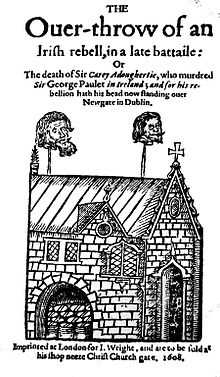Phelim Reagh MacDavitt
| Phelim Reagh MacDavitt | |
|---|---|
|
A contemporary illustration showing the severed heads of MacDavitt (left) and Sir Cahir O'Doherty on display on the walls of Dublin. | |
| Born | Kingdom of Ireland |
| Died |
1608 Lifford, County Donegal, Ireland |
Cause of death | Execution |
| Nationality | Irish |
| Occupation | Landowner, Warrior |
| Known for | O'Doherty's Rebellion |
| Religion | Roman Catholic |
Phelim Reagh MacDavitt or Phelim Reagh MacDevitt (Irish:Feidhlimidh Riabhach Mac Dhaibheid) was a Gaelic Irish warrior and landowner notable for his participation in the Nine Years War and later in O'Doherty's Rebellion in 1608. After playing a leading part in the Burning of Derry, he was captured and executed following the Battle of Kilmacrennan.
Tyrone's Rebellion
The MacDavitts were from Inishowen, in modern County Donegal. They were foster brothers (although some sources say foster fathers) of Cahir O'Doherty, who had the strongest claim to succeed as head of the O'Dohertys. When Cahir was kidnapped by Red Hugh O'Donnell during Tyrone's Rebellion, Phelim Reagh and his brother Hugh Boy MacDavitt changed sides having previously supported the rebels. They now rescued Cahir from captivity and had him proclaimed head of the O'Dohertys by Henry Docwra, the English governor of Derry. Both Cahir and his foster brothers served with distinction on the Crown's side during the war.[1] They were disappointed when the Treaty of Mellifont 1603 restored lands to the rebels that had been promised to them.
Both Cahir O'Doherty and Phelim Reagh had problems with local government officials in the years after the war, once the more friendly Docwra had been replaced. Although naturally loyal, they both felt they were being pushed into rebellion by their treatment. This came to a head when the government ordered O'Doherty to hand over Phelim Reagh because he wanted for arrest over some allegations that had been made. O'Doherty reluctantly turned him over, but applied for his release. Eventually his lobbying was successful, and the government freed him. Ironically this was just in time for him to take part in the rebellion.[2]
O'Doherty's Rebellion
Burning of Derry
O'Doherty planned to begin the rebellion by seizing the garrison town of Derry. MacDavitt helped lead the initial attack and capture of the Upper Fort of Derry. He was on hand when the Governor (who was disliked by both Protestant settlers and Gaelic inhabitants) George Paulet was killed. Derry was then burned to the ground.[3]
Kilmacrennan
MacDavitt was at the decisive battle fought near Kilmacrennan where O'Doherty was killed and the rebels suffered a heavy defeat. MacDavitt was captured in some woods shortly after the battle, where he was cornered by a group of soldiers. He put up fierce resistance and was wounded during his capture.
MacDavitt was the most senior rebel to be executed. He was taken to Lifford and tried by a civilian rather than a military court. Found guilty he was sentenced to be hanged, drawn and quartered, but it is likely he died before most of the sentence was carried out. His and O'Doherty's severed heads were then exhibited on spikes on at the gates of Dublin, a common punishment for treason at the time.
The participation of Phelim Reagh MacDavitt and others of the MacDavitt sept in the attack and destruction of Derry, led to them becoming known as the "burn-Derrys".
References
Bibliography
- Bardon, Jonathan. The Plantation of Ulster. Gill & MacMillan, 2012.
- Falls, Cyril. Elizabeth's Irish Wars. Constable, 1996.
- McCavitt, John. The Flight of the Earls. Gill & MacMillan, 2002.
- McGurk, John. Sir Henry Docwra, 1564-1631: Derry's Second Founder.Fourt Courts Press, 2006.
